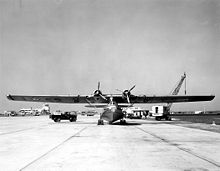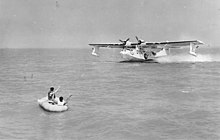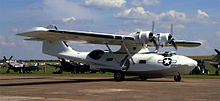Consolidated PBY
| Consolidated PBY Catalina | |
|---|---|
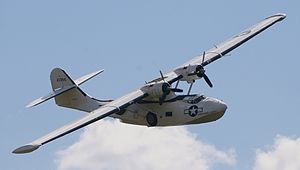 Restored Catalina in the colors and markings of an OA-10A Catalina (44-33915) of the United States Army Air Forces , as deployed by the 5th ERS (Emergency Rescue Squadron) of the 8th Air Force from Halesworth , Suffolk , in early 1945 |
|
| Type: | Maritime patrol aircraft |
| Design country: | |
| Manufacturer: | |
| First flight: |
March 28, 1935 |
| Commissioning: |
October 1936 |
| Production time: |
1936 to 1945 |
| Number of pieces: |
3272 total (1854 flying boats , 1418 amphibious aircraft ) |
The Consolidated PBY "Catalina" was a twin-engine maritime reconnaissance aircraft made by the US manufacturer Consolidated Aircraft (from 1943: Consolidated Vultee ). From 1935 to 1945, a total of 3272 of the flying boats or amphibious aircraft were built and used by the US Navy , the USAAF , the Royal Navy and the Soviet naval forces during World War II .
PB means "Patrol Bomber"; Y is the code for the manufacturer Consolidated ( Vultee ). The nickname "Catalina" refers to Santa Catalina Island off the coast of California.
history
The development of the aircraft began in the spring of 1933. On October 28, 1933, the US Navy ordered a prototype that would compete against the Douglas XP3D-1. Consolidated drew on experience in developing the P2Y . The first flight of the prototype of the "Catalina" (manufacturer designation: Model 28), which was completed in Buffalo (New York) in February 1935 and still carried the designation XP3Y, took place on March 28, 1935. Since the Niagara River was frozen over at this time, it had to the aircraft to be brought by rail to Naval Air Station Anacostia (Washington DC). The designer Isaac Laddon was so convinced of his design that he was on board alongside pilot Bill Wheatley. On June 29, 1935, the Navy ordered 60 machines and in October 1936 the first PBY-1 built in San Diego flew for the US Navy, whereupon another 116 PBY-2 and PBY-3 models were ordered. In 1938 the PBY-4 appeared with the 1200 hp Pratt & Whitney R-1830 Twin Wasp engines and the two glass - enclosed, bubble-shaped observer cockpits on the rear fuselage. On December 20, 1939, the US Navy then ordered 200 copies of the PBY-5, which were intended to protect the neutrality of the United States as long-range patrol aircraft . From May 1941 the machines flew from Newfoundland and later from Iceland .
In addition to Consolidated, three other aircraft manufacturers made the flying boat. Canadian Vickers (later Canadair ) built 380 PBY-5A as PBV-1A, the 150 aircraft in Canadian service were operated under the name "Canso". Boeing Canada in Vancouver built around 300 PBY-5s as PB2Bs, mainly for the British Air Force. The Philadelphia Naval Aircraft Factory built 155 modified PBY-5s under the name PBN-1 Nomad. Canadair was the only manufacturer who continued to produce the PBY-6A version of the flying boat in very small numbers after the end of the Second World War. The Canso was used as a fire fighting aircraft in France, among other places .
In the Soviet Union, 150 "Catalina" were to be built under license as GST (Gydrosamoljot transportny) in Taganrog , but due to production difficulties and the German invasion , only 27 GST were produced by 1941, which were sold by Aeroflot and the polar air fleet under the designation MP-7 were flown. 189 additional PBN-1, PBY-6A and PBY-3 aircraft were delivered under the lend lease agreement. The last of these Catalinas flew with the Soviet Navy until the mid-1950s .
In total, almost 3300 copies ran off the production lines, more than 1400 of them as amphibious aircraft . The Catalina is the most built flying boat to date.
The US Air Force put the Catalina into retirement in 1953, and the US Navy retired the last machine in January 1957.
Construction and use

The structural design resulted in a low, wide, boat-shaped fuselage, which was strongly tapered and ended in a simple vertical stabilizer that carried the horizontal stabilizer about halfway up . The characteristic wide-span wing was mounted in high-decker construction on a pylon with four struts to the fuselage. To protect against splash water, the two Twin Wasp double radial engines were installed as high as possible. In addition, their exhaust gases were used for the first time to de-icing the wing. The support floats were retractable, with the bodies of the floats forming the tips of the wings when retracted. In November 1939 a retractable landing gear version was tested and in 1940 an amphibious version appeared .
Due to its long range - the "Catalina" could stay in the air at 200 km / h for almost 24 hours - the PBY was suitable for long-range reconnaissance and securing of convoy trains. The main task of the machines used in the Atlantic was to track down and fight submarines with depth charges and two torpedoes carried along. In the period between August 1942 and July 1943, Catalinas sunk 14 submarines.
On October 1, 1958, a Taiwanese PBY-5A with seven soldiers, including four US soldiers, was lost on the flight from the Matsu Islands to Taiwan during the Second Quemoy Crisis and could not be found even after a three day search.
British Catalina flying boats participated in the Berlin Airlift and landed on the Havel. They were particularly important for the transport of salt, as their seawater-proof construction withstood the highly corrosive effects of salt dust.
Jacques-Yves Cousteau used a PBY-6A (N101CS) on his diving expeditions. His second son Philippe died in this plane in a failed splashdown in the Tagus River near Lisbon.
Users
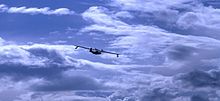
-
 Argentina
Argentina
-
 Australia
Australia
-
 Egypt
Egypt
-
 Ethiopia
Ethiopia
-
 Bulgaria
Bulgaria
-
 Chile
Chile
-
 Denmark
Denmark
-
 Dominican Republic
Dominican Republic
-
 Ecuador
Ecuador
-
 France
France
-
 Haiti
Haiti
-
 Iceland
Iceland
- Coast guard
-
 Indonesia
Indonesia
-
 Israel
Israel
-
 Japan
Japan
-
 Canada
Canada
-
 Colombia
Colombia
-
 Cuba
Cuba
-
 Mexico
Mexico
-
 New Zealand
New Zealand
-
 Netherlands
Netherlands
-
 Norway
Norway
-
 Paraguay
Paraguay
-
 Peru
Peru
-
 Philippines
Philippines
-
 Portugal
Portugal
-
 Spain
Spain
-
 South African Union
South African Union
-
 Sweden
Sweden
-
 Taiwan
Taiwan
-
 Soviet Union
Soviet Union
- Sea aviation
-
 United Kingdom
United Kingdom
-
 United States
United States
- Air Force
- Navy
variants
- XP3Y-1
- Prototype with two 825 hp Pratt & Whitney R-1830-58 engines (BuNo 9459).
- XPBY-1
- Conversion of the XP3Y-1, equipment with 900 hp R-1830-64 engines, rotating gun turret in the bow and a new tail unit. First flight May 19, 1936.
- PBY-1 (Model 28-1)
- Production version with R-1830-64 engines, 60 built.
- PBY-2 (Model 28-2)
- Version with improved avionics and modified tail unit, 50 built.
- PBY-3 (Model 28-3)
- Version with 900 hp R-1830-66 engines, 66 built.
- PBY-4 (Model 28-4)
- Version with 1050 hp R-1830-72 engines and propeller spinners, 33 built.
- PBY-5 (Model 28-5)
- Version with 1200 hp R-1830-92 engines and two teardrop-shaped glazed MG stands on the rear fuselage, 979 built.
- XPBY-5A
- Modification of the last PBY-4 and equipment with a retractable landing gear. First flight on December 22, 1939.
- PBY-5A (Model 28-5A)
- Amphibious version of the PBY-5, partly with improved armament, 782 built.
- PBY-6A
- Amphibious version with a new tail fin, equipped with radar above the cockpit as standard, 175 built (48 sold to the USSR).
- PBY-6AG
- Conversion of a PBY-6A as a VIP transporter for the United States Coast Guard .
- PB2B-1
- Boeing Canada built PBY-5, 165 built. Most were supplied to the Royal Air Force and Royal New Zealand Air Force as the Catalina Mk IVB .
- PB2B-2
- PBY-5 built by Boeing Canada with tailplane of PBN-1, 67 built (mostly delivered to the RAF as Catalina Mk VI ).
- PBN-1
- Version of the US Naval Aircraft Factory's PBY-5. The fuselage was lengthened by about 60 cm, the vertical stabilizer was enlarged, the wing was reinforced, the floats at the wing tips and the avionics were improved. 155 were built for the RAF, 138 of these aircraft were delivered to the USSR.
- PBV-1A
- Canadian Vickers built PBY-5A, 380 built; 150 were delivered as Canso to the Royal Canadian Air Force , the rest to the United States Army Air Forces .
- OA-10
- 230 PBY-5A (A-10 from 1948) delivered to the USAAF for rescue operations.
- OA-10A
- Designation of the PBV-1 of the USAAF (from 1948 A-10A).
- OA-10B
- 76 PBY-6A (A-10B from 1948) delivered to the USAAF.
- Catalina Mk I.
- PBY-5 built for the RAF with 1200 hp R-1830-S1C3-G engines, armament with six 0.303-in-MG, 109 built.
- Catalina Mk IA Canso
- Catalina Mk I , 14 built for the RCAF .
- Catalina Mk IB
- PBY-5A, 225 built under this lending and leasing law for the RAF.
- Catalina Mk II
- Mk I with slightly different equipment, 6 built.
- Catalina Mk IIA
- Catalina Mk II , 50 built by Vickers Canada for the RAF .
- Catalina Mk IIIA
- 12 PBY-5A used by the RAF for the North Atlantic Ferry Service.
- Catalina Mk IVA
- PBY-5, 93 built under the Loan and Lease Act for the RAF.
- Catalina Mk IVB
- PB2B-1, built in 193 as part of the lending and leasing law for the RAF.
- Catalina Mk VI
- PB2B-2, 50 built under the Loan and Lease Act for the RAF.
- GST
- PBY-5 built in the USSR with M-62IR (licensed version of the R-1820-G3) or M-87 engines, about 27 built.
production
The total production of the Consolidated Catalina is difficult to determine. Consolidated produced a total of 2,393 Catalina, including 235 at Consolidated, New Orleans. During the period from 1940 to 1945 Consolidated in San Diego delivered a total of 2,858 Patrol Bombers to the Navy, of which 217 were PB2Y Coronado and 740 PB4Y Privateer, which means that 1,868 aircraft are recorded for the PBY. In addition, the PBY was recreated by two other US plants:
Further production of the Consolidated Catalina by US companies:
| Manufacturer | version | 1943 | 1944 | 1945 | TOTAL |
|---|---|---|---|---|---|
| Consolidated, New Orleans | PBY | 51 | 184 | 235 | |
| Naval Aircraft, Philadelphia | PBN | 39 | 97 | 19th | 155 |
| TOTAL | 39 | 148 | 203 | 390 |
The RAF received a total of 448 aircraft from US production, 174 of which were acquired by the British Air Commission and 274 as part of lend leases. In Canada, 307 British and 424 Canadian Catalinas, a total of 731, were built. 193 aircraft from Boeing, Vancouver, and 2 from Vickers production went to the RAF. The US government took over 520 aircraft from Canadian production for its own account. Canadian Vickers built a total of 369 aircraft, including 230 O-10A for the USAAF and 139 Canso A for the RCAF. Boeing Canada produced 55 Canso A from October 1942 to July 1943 for the RCAF, 240 PB2B-1 from July 1943 to October 1944 and 67 PB2B-2 from September 1944 to March 1945, for a total of 362 Catalina.
Production of the Consolidated Catalina by Canadian companies on US account:
| Manufacturer | version | 1943 | 1944 | 1945 | TOTAL |
|---|---|---|---|---|---|
| Boeing, Vancouver | PB2B-1 | 75 | 148 | 223 | |
| PB2B-2 | 55 | 12 | 67 | ||
| Vickers, Montreal | OA-10A | 4th | 201 | 25th | 230 |
| TOTAL | 79 | 404 | 37 | 520 |
Thus a total of 3,279 Catalinas were built in North America (2,158 Consolidated, San Diego, 235 Consolidated, New Orleans, 155 NAF, 362 Boeing, Canada, 369 Canadian Vickers). Soviet production amounted to one GST in 1939 and 27 in 1940 after Consolidated delivered three aircraft, two of them in parts, as samples.
Technical specifications
| Parameter | Data |
|---|---|
| Type | Sea scouts and submarine hunters |
| crew | 9 |
| length | 19.46 m |
| span | 31.70 m |
| Wing area | 130.06 m² |
| Wing extension | 7.7 |
| Wing loading | 124.00 kg / m² |
| Empty mass | 7,976 kg |
| Max. Takeoff mass | 16,081 kg |
| drive | two radial engines Pratt & Whitney R-1830 , each with 882 kW (approx. 1,200 PS) |
| Top speed | 315 km / h |
| Range | 4,055 km |
| Armament | three 7.62 mm machine guns, two 12.7 mm machine guns, 1,816 kg bomb load |
Incidents
- On July 16, 1948, a Cathay Pacific Consolidated PBY-5A Catalina (VR-HDT) was kidnapped by four men on a flight from Macau to Hong Kong . Shortly after take-off, the captain was killed in a scuffle and the plane crashed into the Pearl River near Zhuhai . Except for one of the kidnappers, nobody survived the crash, a total of 26 people died. It was one of the first aircraft hijackings in the world.
- On May 18, 1952, an amphibious aircraft of the type Boeing-Canada PB2B-1 Canso A (PBY-5A) of Maritime Central Airways (CF-FAN) , with which a cargo charter flight from Gander Airport to Cartwright was to be carried out, crashed while landing in the water the Sandwich Bay . All three people on board the machine were killed in the accident. The cause of the accident was that the pilot in charge had forgotten to retract the landing gear of the machine for the water landing, which created a leverage effect when the wheels touched down and the stern of the machine was immediately levered up into a vertical position in the water (see also the aircraft accident of Maritime Central Airways in the Sandwich Bay ) .
- On May 11, 1953, an amphibious aircraft of the type Boeing-Canada PB2B-1 Canso A (PBY-5A) of the Canadian Pacific Air Lines (CF-CRV) crashed on a water landing in Prince Rupert . One passenger and one crew member died.
- On May 12, 1962, an amphibious aircraft of the type Canadian Vickers PBV-1A Canso (PBY-5A) operated on behalf of Greenlandair of Eastern Provincial Airways (CF-IHA) , with which a domestic flight was to be carried out from Kangerlussuaq to Nuuk , had an accident of water landing in a fjord. After landing, the aircraft filled with water from the bow, after the nose gear flaps had been torn out on landing and the landing gear shaft had been deformed. Since the emergency exits were blocked by pieces of luggage, 15 of the 21 people on board drowned (see also Greenlandair's flight accident at Nuuk 1962 ) .
- On October 19, 1966, a Consolidated PBY-5A Catalina of the Brazilian Cruzeiro do Sul (PP-PEC) crashed on a training flight near its take-off airport at Belem -Val-de-Cans. All four crew members were killed.
- On October 17, 1968, a Consolidated / Canadian Vickers PBV-1 Canso- amphibious aircraft of the Brazilian Cruzeiro do Sul (PP-PCW) had an accident while landing on the Rio Purus near Canutama ( Amazonas (Brazil) ). When touching down, the left wing float touched the water, whereupon the aircraft nose plunged and the cabin overflowed. The plane swam for 15 minutes before it sank. Of the 14 occupants, 4 passengers were killed, all 5 crew members and the remaining 5 passengers survived.
See also
- Catalina Affair , a diplomatic incident between Sweden and the Soviet Union in 1952 in which two Swedish aircraft - including a Catalina - were shot down by Soviet fighters.
literature
- Ulrich Israel: Consolidated "Catalina". In: Wolfgang Sellenthin (Ed.): Fliegerkalender der DDR 1981. Military Publishing House of the GDR, Berlin 1980, ZDB -ID 192211-7 , pp. 138–152.
- David Legg: Consolidated PBY Catalina. The peacetime record. Airlife, Shrewsbury 2002, ISBN 1-84037-276-1 (English).
Web links
- Data and photo on Flugzeuginfo.net
- Catalina Society (English)
- Airworthy PBY-5A Catalina from the Neptun Association in Dutch
- Airworthy PBV-1A Canso from Plane Sailing in English
- GST page in English
Individual evidence
- ↑ WE Scarborough: PBY Catalina in action, Aircraft Number 62. squadron / signal publications, 1983, ISBN 0-89747-149-0 , p. 50.
- ↑ FlugRevue March 2010, pp. 92–95, At home in all elements - Consolidated Catalina.
- ↑ Vladimir Kotelnikov: Consolidated GST. In: Classics of Aviation No. 5/2014, pp. 48–53.
- ^ Ulrich Unger: Adventure of Soviet Aviators . Military Publishing House of the GDR, Berlin 1987, ISBN 3-327-00306-8 , p. 196 .
- ↑ Wilfried Copenhagen: Legendary Airplanes - Consolidated "Catalina". Military publishing house of the GDR, Berlin 1990. ISBN 3-327-00863-9 . P. 98.
- ^ William Wagner: Reuben Fleet and the Story of Consolidated Aircraft. Fallbrock 1976, p. 253.
- ↑ Statistical Digest of the USAF 1946. pp. 100 ff.
- ↑ KJ Meekcoms: The British Air Commission and Lend-Lease. Trowbridge 2000, pp. 54, p. 70.
- ↑ KJ Meekcoms: The British Air Commission and Lend-Lease. Trowbridge 2000, p. 54, p. 155 f.
- ↑ KJ Meekcoms: The British Air Commission and Lend-Lease. Trowbridge 2000, p. 54, p. 192.
- ↑ Peter M. Bowers: Boeing Aircraft since 1916. London 1989, p. 280 f.
- ↑ Statistical Digest of the USAF 1946, p. 100 ff .; Bowers, Peter M .: Boeing Aircraft Since 1916, p. 28 f.
- ^ Lennart Andersson: Aeroflot Origins. Red Stars, Tallin 2009, p. 176 f.
- ↑ Aircraft accident data and report in the Aviation Safety Network (English)
- ^ Accident report PBY-5A CF-FAN , Aviation Safety Network (English), accessed on June 6, 2020.
- ^ Accident report PBY-5A Canso CF-CRV , Aviation Safety Network (English), accessed on November 30, 2017.
- ↑ Accident report PBY-5A CF-IHA in ICAO Circular 71-AN / 63.
- ^ Accident report PBY-5A CF-IHA , Aviation Safety Network (English), accessed on June 6, 2020.
- ^ Accident report PBY-5 PP-PEC , Aviation Safety Network (English), accessed on November 2, 2015.
- ^ Accident report PBV-1 Canso PP-PCW , Aviation Safety Network (English), accessed on August 3, 2020.



